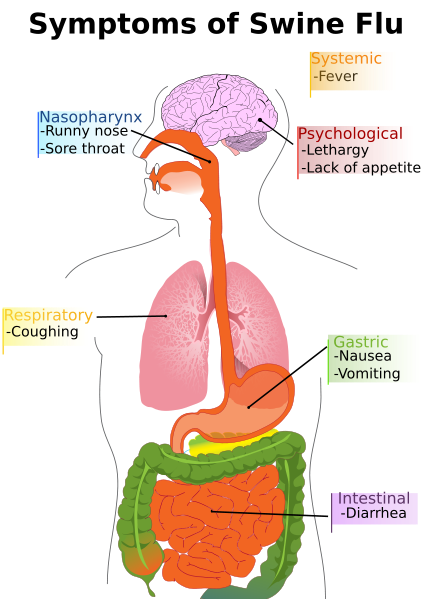H1N1 Virus also known as Swine Flu
Swine influenza (also called swine flu, hog flu, and pig flu) refers to influenza caused by those strains of influenza virus, called swine influenza virus (SIV), that usually infect pigs.[1] Swine influenza is common in pigs in the midwestern United States (and occasionally in other states), Mexico, Canada, South America, Europe (including the United Kingdom, Sweden, and Italy), Kenya, Mainland China, Taiwan, Japan and other parts of eastern Asia.[1]
Transmission of swine influenza virus from pigs to humans is not common and properly cooked pork poses no risk of infection. When transmitted, the virus does not always cause human influenza and often the only sign of infection is the presence of antibodies in the blood, detectable only by laboratory tests. When transmission results in influenza in a human, it is called zoonotic swine flu. People who work with pigs, especially people with intense exposures, are at risk of catching swine flu. However, only about fifty such transmissions have been recorded since the mid-20th Century, when identification of influenza subtypes became possible. Rarely, these strains of swine flu can pass from human to human. In humans, the symptoms of swine flu are similar to those of influenza and of influenza-like illness in general, namely chills, fever, sore throat, muscle pains, severe headache, coughing, weakness and general discomfort.
The 2009 flu outbreak in humans, known as "swine flu", is due to a new strain of influenza A virus subtype H1N1 that contained many genetic elements normally found in swine influenza. The origin of this new strain is unknown, and the World Organization for Animal Health (OIE) reports that this strain has not been isolated in pigs.[2] This strain can be transmitted from human to human, an ability attributed to an as-yet unidentified mutation.[3] This 2009 H1N1 strain causes the normal symptoms of influenza. [Source from http://en.wikipedia.org/wiki/Swine_influenza]
Here is the image of the virus:

REPORT FROM WHO
4 May 2009 -- As of 06:00 GMT, 4 May 2009, 20 countries have officially reported 985 cases of influenza A (H1N1) infection.
Mexico has reported 590 laboratory confirmed human cases of infection, including 25 deaths. The higher number of cases from Mexico reflects ongoing testing of previously collected specimens. The United States has reported 226 laboratory confirmed human cases, including one death.
The following countries have reported laboratory confirmed cases with no deaths - Austria (1), Canada (85), China, Hong Kong Special Administrative Region (1), Costa Rica (1), Colombia (1), Denmark (1), El Salvador (2), France (2), Germany (8), Ireland (1), Israel (3), Italy (1), Netherlands (1), New Zealand (4), Republic of Korea (1), Spain (40), Switzerland (1) and the United Kingdom (15).
There is no risk of infection from this virus from consumption of well-cooked pork and pork products.

This virus have spreaded before and they have the record since 1918. Don't worry because they will find the cure, I think!
In : Free Topics
Tags: h1n1 swine flu
blog comments powered by Disqus












